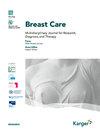Vitamin D and breast cancer risk: evaluating the association and effective risk reduction
IF 2
4区 医学
Q2 OBSTETRICS & GYNECOLOGY
引用次数: 0
Abstract
Introduction. Breast cancer (BC) is the most common cancer among women globally. Vitamin D has been considered a protective factor; however, its relationship with any aspect of the disease remains controversial. Methods. A cross-sectional, single-center clinical study was conducted between 2015 and 2018, including 141 women diagnosed with BC and 239 women in the control group, with mean ages of 43.1 and 41.7 years, respectively (p=0.103). Serum levels of vitamin D and lipid profile were measured. Clinical and nutritional data were obtained through interviews and medical records. Results. The vitamin D dosage presented an average value of 25.5 ng/ml and 31.0 ng/ml in the case and control groups, respectively (p<0.001). The vitamin D cut-off point for discriminating the presence of BC was 27.45 ng/ml. Additionally, low-density lipoprotein cholesterol levels were higher in the case group (121.4 mg/dL) compared to the control group (110.7 mg/dL) (p=0.002), whereas high-density lipoprotein cholesterol levels were lower in the case group (47.6 mg/dL) compared to the control group (53.3 mg/dL) (p=0.001). Alcohol consumption was significantly higher in the case group than in the control group (2.7 vs. 5.3 doses/day; p<0.001). Conclusion. The results indicate a significant association between lower vitamin D levels and BC, persisting after multivariate analysis (p<0.001). These findings could inform prevention strategies, highlighting the importance of maintaining adequate vitamin D levels and potentially identifying a risk group.维生素 D 与乳腺癌风险:评估关联性和有效降低风险
导言乳腺癌(BC)是全球妇女最常见的癌症。维生素 D 被认为是一种保护性因素,但它与乳腺癌的任何方面的关系仍存在争议。研究方法在 2015 年至 2018 年期间进行了一项横断面单中心临床研究,其中包括 141 名确诊为 BC 的女性和 239 名对照组女性,她们的平均年龄分别为 43.1 岁和 41.7 岁(P=0.103)。测量了血清维生素 D 水平和血脂概况。临床和营养数据通过访谈和病历获得。结果显示病例组和对照组的维生素 D 剂量平均值分别为 25.5 纳克/毫升和 31.0 纳克/毫升(P<0.001)。判别是否存在 BC 的维生素 D 临界点为 27.45 纳克/毫升。此外,病例组的低密度脂蛋白胆固醇水平(121.4 mg/dL)高于对照组(110.7 mg/dL)(p=0.002),而病例组的高密度脂蛋白胆固醇水平(47.6 mg/dL)低于对照组(53.3 mg/dL)(p=0.001)。病例组的酒精摄入量明显高于对照组(2.7 对 5.3/天;P<0.001)。结论研究结果表明,维生素 D 水平较低与 BC 之间存在明显关联,经多变量分析后,这种关联依然存在(p<0.001)。这些发现可为预防策略提供参考,突出了保持足够维生素 D 水平的重要性,并有可能识别出风险人群。
本文章由计算机程序翻译,如有差异,请以英文原文为准。
求助全文
约1分钟内获得全文
求助全文
来源期刊

Breast Care
医学-妇产科学
CiteScore
4.40
自引率
4.80%
发文量
45
审稿时长
6-12 weeks
期刊介绍:
''Breast Care'' is a peer-reviewed scientific journal that covers all aspects of breast biology. Due to its interdisciplinary perspective, it encompasses articles on basic research, prevention, diagnosis, and treatment of malignant diseases of the breast. In addition to presenting current developments in clinical research, the scope of clinical practice is broadened by including articles on relevant legal, financial and economic issues.
 求助内容:
求助内容: 应助结果提醒方式:
应助结果提醒方式:


